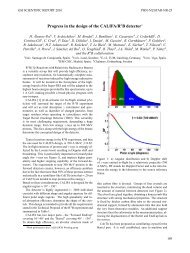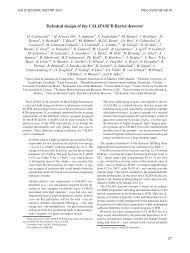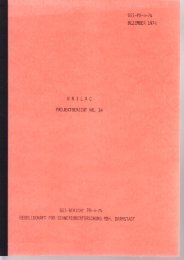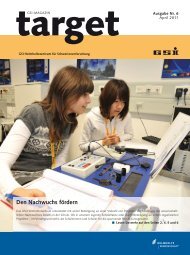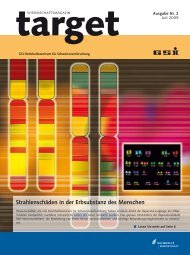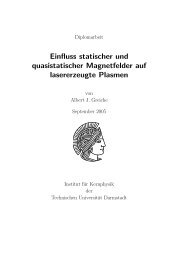download block - GSI Helmholtzzentrum für Schwerionenforschung
download block - GSI Helmholtzzentrum für Schwerionenforschung
download block - GSI Helmholtzzentrum für Schwerionenforschung
Create successful ePaper yourself
Turn your PDF publications into a flip-book with our unique Google optimized e-Paper software.
NUSTAR-SHE-07 <strong>GSI</strong> SCIENTIFIC REPORT 2009<br />
Towards a direct mass measurement of Lr at SHIPTRAP<br />
M. Dworschak 1 , D. Ackermann 1 , K. Blaum 2,3 , M. Block 1 , C. Droese 4 , S. Eliseev 2 , E. Haettner 1,5 ,<br />
F. Herfurth 1 , F.P. He berger 1 , S. Hofmann 1 , J. Ketelaer 6 , G. Marx 4 , D. Nesterenko 7 , Yu. Novikov 1,7 ,<br />
W.R. Pla 1,5 , A. Popeko 8 , D. Rodríguez 9 , C. Scheidenberger 1,5 , L. Schweikhard 4 , P. Thirolf 10 , and<br />
C. Weber 10<br />
1 <strong>GSI</strong>, Darmstadt; 2 MPI-K Heidelberg; 3 Universität Heidelberg; 4 Universität Greifswald; 5 Universität Gie en;<br />
6 Universität Mainz; 7 Petersburg Nuclear Physics Institute; 8 JINR, Dubna; 9 Universidad de Granada; 10 LMU München<br />
The mass of a nuclide is a fundamental parameter. It<br />
provides information about the nuclear binding energy and<br />
is thus crucial for nuclear structure and reaction studies.<br />
Compared to the indirect mass determination via decay energies,<br />
a method in which the mass can be directly obtained<br />
is favorable since it is independent of a detailed knowledge<br />
of nuclear level schemes. Especially in the region of<br />
transuranium nuclides direct mass measurements are desirable<br />
to check the information on the binding energy which<br />
is presently based on spectroscopic data.<br />
The Penning-trap mass spectrometer SHIPTRAP [1]<br />
is presently the only facility where direct measurements<br />
on transfermium nuclides can be performed. After the<br />
first successful experiments on three nobelium isotopes<br />
( =102) [2] the focus was set on extending direct mass<br />
measurements to higher . For the next step the isotope<br />
Lr was selected, which is of specific interest since its<br />
mass, as well as that of its daughter nuclide Md, are<br />
presently only estimated from systematic trends. Furthermore,<br />
two low-lying levels decaying by emission have<br />
been observed. The excitation energy of the isomeric<br />
state could not be determined so far but has to be settled<br />
at . A direct mass determination would<br />
thus provide more information on ground state masses and<br />
would hence be another anchorpoint in an odd-even -<br />
decay chain.<br />
The nuclei investigated at SHIPTRAP were produced by<br />
fusion-evaporation reactions and were separated from the<br />
primary beam by the velocity filter SHIP [3]. Lr was<br />
produced in the reaction Bi( Ca,2n) Lr at a primary<br />
beam energy of 4.55 MeV/u with a cross section of about<br />
200 nb. This corresponds to a rate of about 0.3 ions per<br />
second measured at a position-sensitive silicon detector in<br />
front of SHIPTRAP. The reaction products with kinetic energies<br />
of about 40 MeV were decelerated in degrader foils<br />
and were stopped in a gas cell at 50 mbar helium. The<br />
lawrencium atoms were extracted from the gas as singly<br />
and doubly charged ions.<br />
After the extraction from the gas cell the ions were<br />
cooled and accumulated in an RFQ structure and then<br />
ejected as a short ion bunch. Subsequently, the ions were<br />
injected into a double Penning trap system, which is consisting<br />
of a preparation trap and a measurement trap, placed<br />
in a 7T magnet. In the latter the mass was determined by<br />
measuring the cyclotron frequency of the ions using a<br />
176<br />
time-of-flight cyclotron-resonance-detection technique.<br />
���������������������� �<br />
���<br />
���<br />
���<br />
���<br />
���<br />
���<br />
���<br />
��� �� �<br />
� ��� ���������<br />
���<br />
��� ��� ��� �� �� �� �� � � � � � �� �� ��<br />
������������������������ �<br />
Figure 1: Time-of-flight resonance of Lr . The solid<br />
line is a fit of the theoretical line shape to the experimental<br />
data points.<br />
Altogether around 30 Lr ions were detected in about<br />
30 hours measurement time and the time-of-flight resonance<br />
shown in Fig. 1 was obtained. Lr is thus both,<br />
the heaviest radionuclide and the one with the lowest production<br />
rate ever studied in a Penning trap.<br />
The SHIPTRAP measurements on nobelium and lawrencium<br />
are first steps away from the well-studied region of<br />
known masses towards direct mass measurements of superheavy<br />
nuclides. Further improvements of the experimental<br />
setup will pave the way to address nuclides with even<br />
lower production rates. One goal is to fix the endpoints<br />
of -decay chains originating from superheavy nuclei that<br />
currently are not connected to the area of known nuclei.<br />
This will open up new perspectives for the identification of<br />
long-lived elements on the predicted island of stability.<br />
References<br />
[1] M. Block et al., Eur. Phys. Jour. D 45 (2007) 39.<br />
[2] M. Block et al., Nature, in print (2010).<br />
[3] G. Münzenberg et al., Nucl. Instr. Meth. 161 (1979) 65.


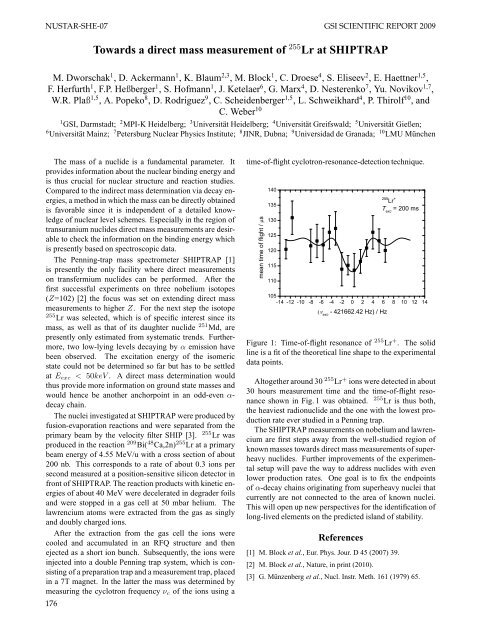


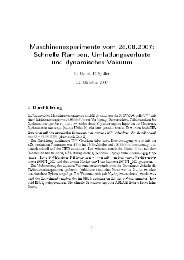
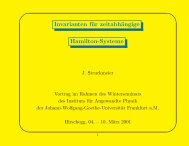
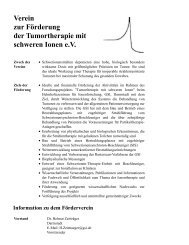
![GS I -P-]-17 - GSI Helmholtzzentrum für Schwerionenforschung](https://img.yumpu.com/20698964/1/184x260/gs-i-p-17-gsi-helmholtzzentrum-fur-schwerionenforschung.jpg?quality=85)

